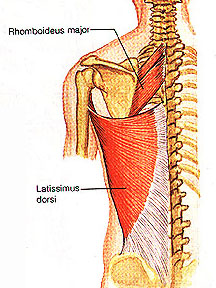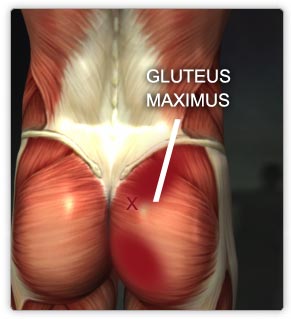The"core". I've bashed conventional core training in my previous posts, but I'll go into further detail today. Core training has been somehow bastardized into abdominal training. The core is a lot more complicated than trunk flexion - you simply cannot it by performing sit ups and crunches!

There are superficial muscles like the rectus abdominus and external obliques, but there are also deeper muscles such as the transverse abdominus and internal obliques - this is just the anterior portion of your midsection. The posterior portion includes another host of superficial and intrinsic muscles that include your spinal erectors and multifidi. Now, in my opinion, the "core" is not just your midsection. I'd say its your entire torso all the way down to your hips, which means we need to include the latissimus dorsi, the glutes, and hip flexors just to name a few.

"You have your ubulus muscle, which connects to your upper dorsimus"
All those different muscles can't be there to just produce trunk flexion. It isn't a functional way to train them, and your other lifts like squats, deadlifts, lunges, presses, and rows will be limited by the weakness of your core. We've always trained the core for strength purposes with sit ups and side bends, etc. but is that its true role? Think about a tennis/golf/baseball player swinging their respective equipment - all the movement and power is generated through the use of their hips and thoracic spine (upper back), all the while maintaining a very ridgid midsection. What about a mother carrying a purse around one arm, with groceries in one hand, while carrying her son in the other? You better believe she's keeping her core tight otherwise she'd tip right over!

Now, check the direction of the different muscles fibers in your abdominals in the first picture I posted. Your rectus abdominus fibers are vertical, the transverse is horizontal, and the internal and external obliques run in diagonals - all of which connect to form a tight, interwoven web. Why is denim so durable?

It's crosshatched. What about an architect designing a house/building?
.jpg)
Same concept. Now, if the core was really designed for trunk flexion - I think it would look more like a hamstring:

Note how the muscle fibers essentially run straight up and down.
Continuing with our discussion of the core musculature. Let's take a closer look at the lats:

Notice how the muscle fibers run diagonally down from the humerus through the thoracolumbar fascia (the white colored fibers) and insert on to the iliac crest. The problem with traditional lat pulldowns and pullups are that they load your muscles in a vertical fashion. Because your lats run diagonally, they are in both a vertical and a horizontal vector. How do we add that horizontal component? We attempt to pull the bar apart. Obviously, the bar isn't going to allow that, but by performing the exercise in this manner, you engage more muscle fibers that woud've otherwise had an unfavorable line of pull.
The hamstrings are comprised of three different muscles: the semitendinosus, semimembranosus, and the biceps femoris (which actually has a short head, as well as a long head).
What we're concerned about here is the biceps femoris. I mentioned before that the hamstring muscle fibers run, for the most part, straight up and down. This is true, but the biceps femoris (BF) actually tracks slightly to attach on to the lateral portion of your knee. Why is this important? If your BF strength isn't up to par, your adductors will win the tug of war of your knee and your patellofemoral joint will literally "cave in" during running, squatting, lunging, climbing stairs, etc. I used to attribute this solely to gluteus medius weakness, but the glute med. is definitely an overrated muscle in this movement impairment. While the BF attaches directly onto the knee, the glute med. influences the knee via the IT(Iliotibial) Band:

Check out the knees of the girl jumping in this video:
Knees collapsing inwards like that is a recipe for an ACL injury. What exercises can we use to help prevent this? You can try squats with a mini band around your knees. Click here for a video with coaching cues by strength coach Mark Verstegen.
You can also try hamstring curls on a stability ball with your feet externally rotated to emphasize the BF.

Now, like I said before, your muscles work in movement patterns in conjunction with other muscles. You need to exercise your glutes as well, which is why I didn't include any exercises that purely "isolate" the BF.
Speaking of glutes:

Your glutes primarily thought of as hip extensors (when you stand up from a chair, as you push your hips forward - you are using your glutes). They are also hip external rotators - meaning they let you do this:

Check out the muscle fiber arrangement of the glutes - they run horizontally. Ask any informed fitness enthusiast on how to build great glutes and they'll generally reply with some sort of squat or deadlift variation. Next time you squat/deadlift/lunge/etc., I want you to think about "gripping" the floor with your toes. From there, as your coming back up from the bottom position, think about "spreading the floor" out from underneath you. In other words, try to externally rotate your feet. Just like you wont be able to pull a bar apart during a pullup, you obviously won't be able to break the floor underneath you, but by consciously trying to rotate your feet outwards, you engage more of the muscle fibers in your glutes, which results in a stronger lift.
I hope these tips add some tools to your training arsenal. Make sure your trainer understands their anatomy!
Train Hard...and smart,
Jason






